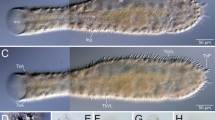Summary
The epidermal cell layer of the apical end of the ceras was investigated in two species of aeolid nudibranchs. Based on cellular inclusions, mostly two cell types were found: mucoid and ellipsoid-vacuolate cells. Mucoid cells ofCoryphella rufibranchialis have large heterogeneous and fibrillar secretory granules whereas inAeolidia papillosa, the granules are homogeneous, but vary in electron density from one cell to another. Ellipsoid-vacuolate cells contained large quantities of small vacuoles with an included ellipsoidal structure. Both species contained very numerous ellipsoid-vacuolate cells. Secretory granules and ellipsoid-vacuoles appear to arise from the Golgi apparatus and these contents stain with PAS, suggesting a polysaccharide composition. Mucoid cells contained both secretory granules and ellipsoid-vacuoles which may arise from the same Golgi apparatus.
Similar content being viewed by others
References
Anderson, P., Slorach, S. A., Uvnas, B., 1973: Sequential exocytosis of storage granules during antigen-induced histamine release from sensitised rat mast cells in vitro: an electron microscopic study. Acta Physiol. Scand.88, 359–372.
Bainton, D. F., Farquhar, M. G., 1966: Origin of granules in polymorphonuclear leucocytes. J. Cell Biol.28, 277–301.
Bonar, D. F., Hadfield, M. G., 1974: Metamorphosis of the marine gastropodPhestilla sibogae (Bergh) (Nudibranchia: Aeolidacea): I. Light and electron microscopic analysis of larval and metamorphic stages. J. exp. mar. biol. Ecol.16, 227–255.
Clark, G., 1973: Staining procedures, 3rd Ed. Baltimore: Williams and Wilkins Co.
Dauwalder, M., Whaley, W. G., Kephart, J. E., 1972: Functional aspects of the Golgi apparatus. Sub-Cell. Biochem.1, 225–275.
Fitton-Jackson, S., 1964: Connective tissue cells. In: The Cell, Vol. VI (Brachet, J., Mirsky, A. E., eds.). New York: Academic Press.
Foreman, J. C., Mongar, J. L., Gomperts, B. D., 1973: Calcium ionophores and movement of calcium ions following the physiological stimulus to a secretory process. Nature245, 249–251.
Friend, D. S., 1969: Cytochemical staining of multivesicular body and Golgi vesicles. J. Cell Biol.41, 269–279.
Hyman, L. H., 1967: The invertebrates: Vol. VI, Mollusca I. New York: McGraw-Hill Book Co.
Ito, S., Winchester, R. J., 1963: Gastric mucosa in the bat. J. Cell Biol.16, 541–577.
Lagunoff, D., 1973: Membrane fusion during mast cell secretion. J. Cell Biol.57, 232–250.
Lawson, D., Martin, C. R., Gomperts, B., Fewtrell, C., Gilula, N. B., 1977: Molecular events during membrane fusion: A study of exocytosis in rat peritoneal mast cells. J. Cell Biol.72, 242–259.
Neutra, M., Leblond, C. P., 1966: Synthesis of the carbohydrate of mucus in the Golgi complex as shown by electron microscope radioautography of goblet cells from rats injected with glucose-H3. J. Cell Biol.30, 119–136.
—,Schaeffer, S. F., 1977: Membrane interactions between adjacent mucous secretion granules. J. Cell Biol.74, 983–991.
Palade, G., 1975: Intracellular aspects of the process of protein synthesis. Science189, 347–358.
Pearse, A. G. E., 1968: Histochemistry theoretical and applied, Vol. I, 3rd Ed. London: Churchill Pub. Co.
Rohlich, P., Anderson, P., Uvnas, B., 1971: Electron microscopic observations on compound 48/80-induced degranulation in rat mast cells. J. Cell Biol.51, 465–483.
Salema, R., Brandão, I., 1973: The use of PIPES buffer in the fixation of plant cells for electron microscopy. J. Submicr. Cytol.5, 79–96.
Schmekel, L., Wechsler, W., 1967: Elektronenmikroskopische Untersuchungen über Struktur und Entwicklung der Epidermis vonTrinchesia granosa (Gastropoda, Opistobranchia). Z. Zellforsch.77, 95–114.
Spurr, A. R., 1969: A low-viscosity epoxy resin embedding medium for electron microscopy. J. Ultrastruct. Res.26, 31–43.
Storch, V., Welsch, U., 1972: The ultrastructure of the epidermal mucous cells in marine invertebrates (Nemertini, Polychaeta, Prosobranchia, Opisthobranchia). Mar. Biol.13, 167–175.
Swift, J. G., Mukherjee, T. M., 1978: Membrane changes associated with mucus production by intestinal goblet cells. J. Cell Sci.33, 301–316.
Tandler, B., Poulsen, J. H., 1976: Fusion of the envelope of mucous droplets with the luminal plasma membrane in acinar cells of the cat submandibular gland. J. Cell Biol.68, 775–781.
Wise, G. E., Flickinger, C. J., 1970: Cytochemical staining of the golgi apparatus inAmoeba proteus. J. Cell Biol.46, 620–626.
Author information
Authors and Affiliations
Rights and permissions
About this article
Cite this article
Porter, K.J., Rivera, E.R. The Golgi apparatus in epidermal mucoid and ellipsoid-vacuolate cells ofAeolidia papillosa andCoryphella rufibranchialis (Nudibranchia) . Protoplasma 102, 217–233 (1980). https://doi.org/10.1007/BF01279589
Received:
Accepted:
Issue Date:
DOI: https://doi.org/10.1007/BF01279589




